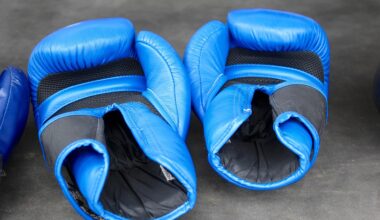Optimizing Sleep Patterns to Enhance Football Performance
Football players must prioritize their sleep patterns to achieve peak performance on the field. Sleep is essential for recovery, energy regeneration, and cognitive function. Studies show that consistent sleep reinforces learning and enhances reflexes, significantly impacting overall skill execution during games. Coaches should advocate for strategies that help their players establish healthy sleep routines. Factors such as sleep duration, quality, and timing play a crucial role in performance. Aiming for seven to nine hours of restorative sleep each night ensures athletes feel revived. Additionally, sleep hygiene practices, like a dark and cool room, can promote better rest. Regular sleep schedules help synchronize the body’s internal clock, which is vital for consistent performance. Athletes often face travel and irregular training schedules, complicating their sleep patterns. Simple adjustments can be made, such as minimizing screen exposure before bedtime and using relaxation techniques for better sleep onset. Ultimately, investing in good sleep habits not only improves physical performance but also boosts mental clarity, allowing athletes to excel in their roles and responsibilities, consequently enhancing teamwork and success.
Understanding the various stages of sleep can also benefit football players. Sleep consists of different cycles, including REM and non-REM sleep. Each stage serves specific bodily functions that are critical for athlete recovery. During non-REM sleep, muscles repair, and growth occurs, while REM sleep fosters memory consolidation and emotional processing. Footballers should aim to ensure they complete sufficient sleep cycles each night, ideally matching their recovery needs. Engaging in a pre-sleep routine, such as reading or meditating, can greatly enhance their sleep quality. Learning to listen to their bodies can inform athletes when to rest, making them cognizant of how fatigue affects their performance. Implementing relaxation techniques, such as breathing exercises, may also trigger better sleep quality. Additionally, nutrition can influence sleep patterns as well. Eating a balanced diet rich in vitamins and minerals promotes not only athletic performance but healthy sleep. Emphasizing magnesium-rich foods, like leafy greens, bananas, and nuts, can help relax muscles. Implementing these practices collectively contribute to optimized sleep, and ultimately improved athletic results, making rest an integral part of any training regimen.
The Impact of Naps on Athletic Performance
Incorporating naps into a football training schedule can be immensely beneficial. Short naps of 20 to 30 minutes can enhance alertness, focus, and energy levels without causing sleep inertia. This practice allows players to recharge during the day. Research supports this, showing that napping boosts cognitive capabilities and overall performance metrics. Players should integrate strategic napping post-training or before matches to refresh mentally and physically. However, longer naps exceeding 30 minutes may disrupt nocturnal sleep patterns if not timed correctly. Scheduling them strategically, ideally before 3 PM, ensures that players can achieve restful nightly sleep. Creating an ideal napping environment, similar to nighttime routines, is crucial for maximizing the benefits of daytime rest. Darkening the area and minimizing noise can facilitate quicker transition into sleep. Communicating the necessity of these practices among players and coaching staff is vital for consistent implementation. When embraced as part of overall training discipline, napping can serve as a powerful tool for enhancing athletic performance and readiness. As such, footballers should not underestimate the advantages of optimally timed naps.
The role of technology in monitoring sleep patterns is becoming increasingly relevant for athletes. Wearable devices designed to track sleep quality, duration, and efficiency are now widely available. Football players can utilize these tools to gain insights into their sleep behaviors, enabling them to make informed adjustments to improve their recovery. By analyzing sleep data, they can identify trends and patterns, enhancing their understanding of how their daily practices affect performance. However, players must be cautious not to become overly reliant on technology. Striking a balance between monitoring and intuitive connection with their bodies remains essential. Educating players about interpreting their data products can enhance awareness of sleep’s role in health. Coaches should encourage players to combine insights from devices with self-assessment, ensuring they remain aware of their personal needs. This can foster a culture of accountability regarding rest and recovery practices. Ultimately, the combination of modern technology with traditional wisdom about sleep provides an effective approach to optimize sports performance. Champions can emerge through consistent evaluation of these practices leading to refined skills and overall outcomes.
Creating a Supportive Sleep Environment
Building an atmosphere conducive to restful sleep is critical for footballers aiming to enhance their performance. Athletes should invest time in configuring their sleeping quarters for optimal rest. Factors such as room temperature, light exposure, and noise levels play pivotal roles in influencing sleep quality. Ideally, bedrooms should be cool, dark, and quiet, distinguishing a sanctuary for recovery. To promote healthy sleep habits, consider blackout curtains to block excess light and earplugs to silence distractions. The choice of bedding, including pillows and mattresses, must also support comfort to facilitate a restful night’s sleep. Players need to ensure their bedding meets their personal preferences for firmness and support. Furthermore, incorporating calming scents, like lavender, can provide an extra layer of relaxation. Rituals promoting quietude before bedtime, like gentle stretches and calm conversations, may induce more profound relaxation. Removing electronic devices from the bedroom limits interruptions, thus fostering favorable sleep conditions. As footballers prioritize sleep environments, the tangible results in performance on the field can illustrate the profound impact of well-optimized rest.
Group awareness regarding healthy sleep practices among football teams can also enhance collective performance. Promoting open talks surrounding sleep might help demystify misconceptions and encourage teammates to share coping mechanisms. Hip communication can lead to shared experiences that bolster motivation in adhering to healthy sleep schedules. Integrating educational discussions about sleep among training sessions could normalize rest talks. Sharing sleep-related articles or research findings can foster a heightened awareness of the importance of sleep. Coaches can establish team guidelines centered on prioritized sleep routines, creating a cohesive culture supporting rest. Moreover, creating accountability partnerships within teams for encouraging peers to adhere to these practices can offer peer support. This strategy cultivates positive peer pressure, leading to improved routines. Ultimately, fostering a communal commitment to healthy sleep patterns can help athletes collectively sustain their athletic progression. The outcomes of such initiatives manifest as improved performance during matches, demonstrating how aggregate efforts toward healthy practices lead to reciprocal gains. Recognizing sleep’s contribution towards holistic player wellness and performance marks a critical evolution within team dynamics.
Conclusion and Future Directions
Acknowledging sleep as a central component of athletic conditioning is pivotal in football fitness. Players must integrate these sleep practices into their training programs deliberately. Future directions should revolve around enhancing education around sleep for athletes at all levels. Prioritizing sleep equates to prioritizing performance; improved recovery results in superior adaptation to training stresses. Overall, the interplay between sleep, performance, and recovery illustrates a holistic approach to athlete wellbeing. Coaches play a vital part in this evolution, advocating for and implementing policies that foster healthy sleep habits within their training environments. Teams could benefit from periodic assessments of their sleep quality and adjustments in schedules to accommodate optimum rest. Research within sports science should continue exploring the intricate relationship between sleep and performance indices. Understanding these connections may lead to innovative recovery strategies that reflect evolving athletic demands. As teams and organizations invest in educating athletes on sleep patterns, the result could yield enhanced performance metrics and peak career longevity. Embracing sleep’s potential to elevate football fitness is an exciting frontier towards athletic excellence.
Ultimately, football fitness encompasses more than training and diet; it significantly involves rest and recovery. Proper sleep serves as the foundation for physical and mental resilience in football performance. Through a multifaceted approach that incorporates routine, environment, technology, and community engagement, players can optimize their sleep patterns for profound gains in athletic performance. Championing sleep awareness among athletes can cultivate a culture of excellence that extends beyond the pitch. Creating sustainable habits and supportive environments within teams can drive collective performance advancements, molding a dedicated football fitness landscape that acknowledges the vital role of sleep. Enhancing awareness and promoting best practices ensures that both individual players and entire teams can succeed in their athletic journeys. Making sleep a priority allows footballers to tap into their full potential on the field, showcasing their commitment to the sport and dedication to performance and teamwork. The correlation between adequate sleep and robust performance proves too significant to overlook; it shapes not only the athletes of today but also the future stars of football.


